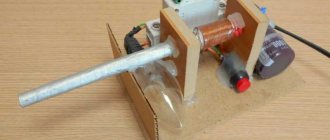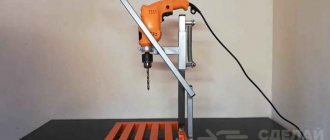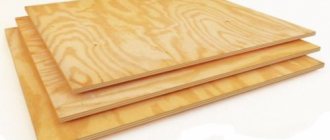Cellar lift
Descent into the basement, especially with a load, is quite difficult for many of its owners. In this case, a do-it-yourself elevator to the basement can be a real lifesaver.
Making the device yourself is much more time- and cost-effective. All that is needed in this case is a set of tools that will be simple and easy to use.
The article proposes to consider how to make a simple elevator for descending into the cellar.
Features of manufacturing a cellar elevator
An elevator is a fairly heavy structure; its fixation area is a load-bearing wall.
When planning the manufacture of a home elevator, you need to understand that this is a heavy structure that needs a strong, reliable support and foundation.
When making a cellar lift with your own hands, you must follow these rules:
- Follow the manufacturers' instructions for the components that will be used during assembly.
- Build a powerful foundation designed to support the weight of the frame, equipment, people and cargo, plus a reserve of at least 30%.
- The guides can only be attached to concrete or brick walls with a thickness of two stones or more.
- Have sufficient space to accommodate the cabin and platform. These are quite voluminous structures that require a lot of space.
The possibility of a power outage or sudden failure of one of the mechanisms should be considered. For such cases, a portable or stationary ladder and a battery-powered light source should be prepared. Another effective solution is a hand winch. The ascent and descent will be slower, but the elevator will remain operational.
What nuances are taken into account?
The question often arises, which door to choose. At the moment there are two types of structures. These are swing and telescopic. But the decision is not made only at personal discretion. Seats in the stopping and boarding area are taken into account. For the first option you need to have more free space. Telescopic is an opportunity not to take up much space in the hall. If there are no problems with space limitations, then you can choose any.
Roller blinds are one of the simplified options in terms of installation and cost. In order for such a structure to move, a winch with a power reserve is mounted. In addition, reliable components are purchased:
In addition, the cabin frame is prepared in advance. For this, a metal profile is used (the strongest one is selected), after which it is sheathed with the selected material (wood, plastic, etc.).
Requirements for a home lift
The main criterion for an elevator is its load capacity.
To make a cellar elevator with your own hands, you need to carefully study the structure of this structure and the requirements that apply to it.
Standard elevators consist of the following parts and mechanisms:
- Lifting device. Operates by manual force or electricity.
- Platform. A base used to accommodate a movable fragment.
- Cabin. Designed to accommodate a person and cargo. Can be open or closed.
- Rails. They are mounted on the wall and serve as guides for the movement of the cabin.
- Controls. These include starters, relays, fuses and other parts that regulate the operation of the structure.
A homemade elevator to the cellar must meet the following criteria:
- safety;
- sufficient load capacity;
- ease of use;
- efficiency;
- availability of an insurance system;
- aesthetics;
- durability;
- Possibility of DIY installation.
When choosing a control method, it is recommended to use a remote control with lifting, lowering and emergency stop buttons.
Safety
Be sure to periodically inspect the elevator parts. We pay special attention to the cable, checking:
presence of lubricant; •
uniform laying on the drum;
•
no kinks or breaks in weaving threads;
•
serviceability of the cable fastening units on the drum and elevator frame.
Electromechanical elevator motor with winch
It would be useful to make a simple but effective safety system in case the main cable breaks. To do this, we simply take a pair of ratchets from the inertial seat belts of a passenger car and install a drum with a safety cable between them. Assembling and fastening such a mechanism will not cause any particular difficulties, and its reliability is quite sufficient to support the significant weight of the elevator with a passenger.
In a control unit for a do-it-yourself elevator, it is preferable to use buttons without locking. According to the principle: “pressed - it goes, let go - it doesn’t go.” And be sure to provide an emergency power off button. power supply in case of “stuck” control button.
In addition, be sure to ensure reliable grounding of the elevator electrical equipment.
We haven't mentioned the finishing of the elevator car. This can be either painting the metal parts (the link describes how to properly paint metal) of the elevator, or covering it with sheet materials, such as OSB, followed by cladding. It seems that, having solved the constructive part of the question of how to make an elevator with your own hands, the finishing work will not be particularly difficult for you.
Leave your tips and comments below. Subscribe to our newsletter. Good luck to you and good luck to your family!
In the first part of the article, we talked about the difficulties that await those who are thinking about having their own elevator in the house. Of course, for true “do-it-yourselfers” who are firmly confident in their own engineering abilities, they only inspire (to try) and provoke (to discuss). Especially those who have already made a similar elevator at home. And as their experience shows, an attentive mechanic and owner always have time for regular technical inspection and installation of numerous “protective” devices.
User Tehnoman identifies the following components of a “home” elevator:
1. Pit equipment: speed limiter tensioner. 2. Drive (winch). 3. Cabin:
General cleaning of the apartment, what does it include?
4. Counterweight. 5. Installation of guides. 6. Mine door. 7. Speed limiter.
Judging by the stories of portal participants, they adhere to exactly this layout (with minor variations).
. Several years ago, the user Grandfather completed renovations in an old village house. After all the alterations, he ended up with a spacious living room downstairs and a bedroom in the attic. All that remained was to make the stairs to the attic. However, after studying all the options, the craftsman abandoned this idea: the staircase would take up too much space, reducing the area of the room. As a result, he decided to make a device that, according to its characteristics, is classified as an elevator, since “an elevator is a more complex structure.”
However, it performs its functions properly. “I’ve been using the lift for three years, I’m very pleased,” Dedush wrote in 2014.
The design of the device is simple, he claims. The main parts of the lift are a cabin, guides with rollers, an electric hoist and control buttons with limiters. Cabin dimensions: 600*600 mm (length-width), height – 1800 mm. The side and rear walls of the cabin have continuous fencing; the top and entrance are left without fencing. The frame is made of a 45*45 mm bar. An electric hoist with a lifting capacity of 300 kg is located behind the attic wall on the ceiling. The support rope runs along the wall.
According to the user, the hardest thing for him was choosing the guides and rollers for the cabin. As a result, the search led to guides and rollers for hanging doors weighing up to 100 kg. The rollers are installed in 2 pieces at the top and bottom of the cabin - the top pair works to separate the guides, the bottom pair works to compress.
The cabin of such an elevator is designed for one person weighing up to 130 kg. To control the lift, three double (up and down), self-returning buttons are used: as long as you hold the button, the lift goes up or down. When you let go, it stops. The entire control system is switched to 12 volts. At the top and bottom, the circuit includes limit switches that provide stopping in the extreme positions of the cabin. Movement speed is 15 cm per second.
Types of elevators to the basement
Lift with electric motor
The basement lift can be equipped with various types of drives, differing in the operating principle of the applied force.
Electrical structures are equipped with a motor, gearbox and winch. The movement of the cabin is carried out by winding and unwinding the cable from the drum. To ensure smooth movement and reduce the load on the motor, the platform is equipped with a counterweight, the mass of which matches the moving part or slightly exceeds it. The system is reliable, but subject to rapid wear due to the presence of many parts that rub under load. The device produces a loud noise that can be heard in all corners of the building.
Hydraulic elevators operate quietly; the load is lifted by a piston into which a special liquid is pumped through a high-pressure hose. The power plant can be located below, above, even to the side of the shaft. In case of power outages, provision is made for the installation of hand pumps. The downside of this solution is the likelihood of hose ruptures and oil contamination of the entire basement.
The pneumatic elevator moves by creating a vacuum in one of the chambers under the influence of pressure pumps. The devices are safe, reliable, but rarely used. This is justified by their high cost, insufficient power and difficulty in maintenance.
As an option, you can consider mechanical lifts. To move the cabin, muscular force is applied to the drum. To increase torque, extended handles or large steering wheels are used.
Operating principles of various elevator systems
Elevator lifts are divided into the following main types:
1) Electric
(electromechanical).
2) Hydraulic
.
3) Pneumatic
(air lift).
DIY elevator guides
To move the elevator, some kind of power device is required, the most convenient and practical power supply for which is electricity. Therefore, electric motors are part of the drive, regardless of its type. However, it is customary to call the elevators of the most common cable system electric, probably because in them the engine force is directly transmitted to the cables that move the cabin.
1. Electric elevator
, which we use in multi-storey buildings, works on the principle of a counterweight: the cabin is fixed on cables, at the other ends of which a counterweight is attached. The drive mechanism, located in the upper part of the elevator (engine room), having received an electrical signal from the panel buttons, sets the system in motion through a pulley wheel. Thanks to the counterweight, cabin inertia is reduced to a minimum, which ensures smooth movement and allows you to get by with a significantly lower power electric motor.
2. Hydraulic lift
works on the principle of a jack. The electric motor creates fluid pressure in the system, and the hydraulic cylinder pushes the cabin upward. No electricity is consumed during descent. This type of elevator has no counterweights and is silent. But due to the high pressure in the hydraulic system, it requires qualified maintenance and a powerful power plant.
3.
The pneumatic elevator
cabin works like a piston. To move the elevator upward, a vacuum of air is created in the air shaft above the cabin by powerful fans. As a result, increased pressure under the cabin pushes it upward. To descend, the pressure at the top and bottom of the cabin is equalized, and it smoothly goes down.
DIY pneumatic elevator
Now let’s ask ourselves the question: how to make an elevator with your own hands in the house, is it feasible for your hands and wallet?
A pneumatic elevator requires components that are almost impossible to make with your own hands. If you buy ready-made ones or order their production, the very idea of making an elevator with your own hands is lost. And the final cost will be rounded up to such a figure that purchasing and installing a ready-made airlift will cost less.
DIY hydraulic lift
Now - hydraulics
. Alas, it is no less difficult and expensive. A high-performance hydraulic pumping station will be required, and it is not cheap. Well, and most importantly – the hydraulic cylinder. Even raising an elevator car one floor requires significant extension of the rods. Dump trucks have similar units, but even if we decide to install such a hydraulic cylinder, we will be faced with another problem - lowering the cab. Automotive-type hydraulic cylinders fold under the weight of the heavy load bed of the dump truck. The weight of the elevator car will not be enough here. Combining various other ready-made mechanisms will be no less difficult and expensive.
The solution to the question of how to make an elevator yourself is obvious: make an electromechanical
.
Preparation for installation
To make an elevator with your own hands, you will need a welding machine.
The success of all subsequent actions largely depends on the correct execution of the preparatory stage of work. First you need to choose the type of elevator, decide on its installation location, and draw up a detailed diagram. Then you need to make calculations and purchase the necessary property.
To build an elevator to the basement with your own hands you will need the following tools:
- welding machine;
- Bulgarian;
- perforator;
- screwdriver;
- spanners;
- electric drill;
- roulette;
- square;
- soldering iron;
- screwdrivers;
- level;
- paint brush.
Worm gearbox
Material list:
- channel;
- rails;
- steel corner;
- drum;
- cable;
- worm gear;
- rollers;
- telpher;
- Electrical engine;
- winch;
- power cable;
- actuator;
- profile pipes;
- anchor bolts;
- mounting boxes;
- acrylic paint;
- anti-corrosion agents.
You need to think through safety issues in advance. Effective ventilation and lighting should be provided, and a respirator, helmet, safety glasses and gloves should be prepared.
Safety
Be sure to periodically inspect the elevator parts. We pay special attention to the cable, checking:
•
presence of lubricant;
•
uniform laying on the drum;
•
no kinks or breaks in weaving threads;
•
serviceability of the cable fastening units on the drum and elevator frame.
Electromechanical elevator motor with winch
It would be useful to make a simple but effective safety system in case the main cable breaks. To do this, we simply take a pair of ratchets from the inertial seat belts of a passenger car and install a drum with a safety cable between them. Assembling and fastening such a mechanism will not cause any particular difficulties, and its reliability is quite sufficient to support the significant weight of the elevator with a passenger.
In a control unit for a do-it-yourself elevator, it is preferable to use buttons without locking. According to the principle: “pressed - it goes, let go - it doesn’t go.” And be sure to provide an emergency power off button. power supply in case of “stuck” control button.
In addition, be sure to ensure reliable grounding of the elevator electrical equipment.
We haven't mentioned the finishing of the elevator car. This can be either painting the metal parts (the link describes how to properly paint metal) of the elevator, or covering it with sheet materials, such as OSB, followed by cladding. It seems that, having solved the constructive part of the question of how to make an elevator with your own hands, the finishing work will not be particularly difficult for you.
Leave your tips and comments below. Subscribe to our newsletter. Good luck to you and good luck to your family!
Source
Place for arranging an elevator
The corner is the best place to install a lift.
A finished lift should provide comfortable conditions for operation. The design should help and not hinder economic activity.
First of all, it is necessary to provide for the issues of ensuring and maintaining the strength of the load-bearing structures of the building. The total weight of the elevator along with its cargo can reach a ton, and this is a large load on the floor and walls of the cellar. The best option is considered to be a monolithic box made of reinforced concrete, where all components have a sufficient margin of safety, and the additional weight is evenly distributed over the slab. The minimum thickness of the slab is 10 cm. If this figure is less, then the base will need to be reinforced.
There are these options:
- Make an external tunnel under the foundation. Place several large stones in it and fill them with cement mortar.
- Drill four holes in the slab and make an extension on top. Fill the wells with reinforcement and fill them with concrete.
- Place an additional screed 5-10 cm thick on top of the existing base.
- Fix and putty the rebar grid on the walls. Another way is to screw two reinforced concrete columns with anchor bolts.
The best place to install an elevator is the corner of the cellar. There the floor is stronger and there are two walls for attaching the guides.
Hatch design
You need to know the basic dimensional parameters and features of the mechanical device.
These options include:
1. Dimensions:
- external - common around the perimeter;
- landing - installation hole in the underground;
- light clearance - the clear size of the opening;
- door size.
2. Design:
- frame made of steel angle with seal;
- prefabricated metal hinge for fastening the door;
- welded metal cover with an internal tray and an outer steel rim around the perimeter;
- latch lock;
- gas stops with lock.
For silent closing and sealing, a seal is placed around the perimeter of the frame, inserted into grooves or glued. The door of even a small metal hatch is quite heavy; pneumatic shock absorbers greatly facilitate the process of use. On the lid there is a welded pallet with additional stiffening ribs. The base for the floor covering or insulation is installed in it. On the surface there are holes for removable handles.
The thickness of the metal is calculated depending on the expected load. Products are painted with powder paint with the addition of polymers. More expensive models can be made of stainless steel, aluminum, and brass. Recently, composite materials have been used for small hatches.
Installation nuances
The frame is installed until the final concrete screed is poured; it must be level with the floor. It is first necessary to decide on the model of the revision design.
Sequence of work:
- The opening is being prepared. It is better to adjust the size of the entrance to the underground using a metal profile.
- Installation of the hatch under tiles and other coverings is carried out after the rough screed, taking into account the rise to the finishing level.
- Secure using fasteners such as dowels or long self-tapping screws.
When purchasing an entrance to the basement, take into account:
- Overall dimensions of stored items. If there are large barrels in the cellar, then it is necessary to take into account that they need to be lifted and sanitized periodically. The opening is especially carefully calculated when it comes to installing technical equipment that needs to be serviced and its individual elements replaced.
- The environment in which the hatch or massive inspection entrance is operated. For a wet basement, it is better to choose materials that are not susceptible to corrosion. Good sealing is needed if the underground is located in a residential area to prevent odors from leaking out.
- Load on the surface of the cover. Garage, technical hatch should be more durable.
- Type of floor covering, its thickness.
- The physique of the owners of the house.
- Price.
Manufacturers and cost
1. One of the leading companies in Russia is Praktika. She patented the design of invisible hatches for Portal series tiles with a hinged system. They are made of steel coated with metal powder paint. When you press the built-in button, the hatch, equipped with a shock absorber, opens easily and effortlessly. It is enough to slightly pull it towards you. The Praktika-yug company produces inspection hatches for the basement, which do not require preliminary preparation of the base for the final decorative coating.
3. The Revizor factory produces hatches with pneumatic cylinders, reinforced with zigzag stiffeners, and a rubber seal. Thanks to this mechanism, they can be used in wet rooms (swimming pools, baths). One- and two-door revisions can withstand increased loads.
4. The Diva company produces a wide range of products from small hatches to non-standard large-sized models with several opening doors, which can be equipped with electric drives.
Manufacturers produce structures of non-standard sizes, according to special projects.
| Company | Material | Dimensions, mm | Price, rub |
| Revizor | Aluminum, galvanized steel | 600 x 600 | 9 660 |
| 700 x 800 | 14 350 | ||
| 900 x 900 | 14 230 | ||
| 1100 x 1100 | 18 440 | ||
| LLC Diva | Steel, powder coated | 600 x 600 | 6 600 |
| 700 x 700 | 8 550 | ||
| 800 x 600 | 8 550 | ||
| 900 x 700 | 9 450 | ||
| 900 x 900 | 10 350 | ||
| 1200 x 800 | 11 550 | ||
| Design and production company Praktika | Painted steel profile | 692 x 692 | 9 950 |
| 692 x 992 | 11 100 | ||
| 792 x 792 | 10 600 | ||
| 892 x 892 | 11 300 | ||
| 992 x 992 | 11 950 |
Before buying a hatch, read the information about the device, manufacturers, and materials. It is better to decide on the model at the design and construction stage so that it corresponds to the overall dimensions of the basement and its purpose.
Installing an elevator in a private house yourself
Lift Project
Installing the lift may require the help of a partner, since you will have to deal with quite heavy objects, and you will also need support for attaching them.
Construction should be carried out in the following sequence:
- In accordance with the project, apply markings to the floor, ceiling and walls. Double-check their accuracy, compare horizontals and verticals.
- Make a frame for the movement of the cargo compartment. A closed loop is made, which is rigidly attached to the supporting structures of the building. Rails are attached to the frame as guides for the rollers.
- Assemble the cabin. A channel is used for the frame and a reinforcement grid for the floor. The structure is equipped with railings and a swing door. If necessary, the walls are covered with steel mesh.
- Install the support beam onto the frame. Then attach the power mechanisms of the engine, gearbox, winch and clutch to it.
- Connect the lifting device and the cabin. Attach the cable and band brake.
- Check the quality and reliability of connections, eliminate curvature and play.
- Clean the metal from scale and rust. Treat it with anti-corrosion agent and paint.
- Supply electricity. Make channels for the cable, secure mounting boxes, remote controls and switches.
- Test the device in different operating modes, with maximum load. Check the operation of the protection when the light goes out and the operation of the emergency braking device.
Upon completion of installation, you need to go upstairs and lower the cabin to the bottom position to remove the load from the supporting structures.
Homemade lift and mini-crane: inexpensive and effective
Building a house alone is possible, but difficult. Especially if you have to lay stone walls, lift bricks to the second floor, or “throw” sand and bags of cement onto the ceiling. So as not to overstrain yourself. To save on ordering a crane and, in general, to simplify your task, many FORUMHOUSE users make mini-cranes and hoists. In this article we will talk about two successful designs.
- Automatic lifting and unloading mechanism for bulk materials
- Homemade crane based on an electric hoist for lifting aerated concrete
How to make a crane for lifting slag, sawdust and sand
I'm building a house. I try to do without helpers. I want to fill the attic floor with insulation - 20 cubic meters of sawdust and 10 cubic meters of slag. The age is no longer the age to run back and forth with buckets. I decided to make a collapsible automatic lift for bulk materials. And this is what I got.
To make a homemade lift you need:
- Electric hoist, power 0.9 kW with a maximum load capacity of 500 kg.
- A trough or body from a garden wheelbarrow, with a load capacity of 250 kg.
- 12th steel I-beam.
- 8 pcs. bearings for rollers.
- Electrical cable.
First make the carriage. How it is arranged can be seen in the photo.
Secure the beam, at the end of which a restrictor plate and a bracket for the carriage movement roller are welded.
The internal stop (support for the carriage in the attic) is detachable. The hoist assembly with the carriage is driven onto an I-beam, after which the limiter is screwed on.
Important!
The beam is installed with a slope of 3 cm per 1 linear meter. Due to this, the carriage with the load moves into the attic itself
.
The carriage is pulled back to the end of the beam with a rope thrown over a roller. The same rope holds the carriage so that the load, after lifting, does not move uncontrollably to the unloading site.
The telpher is placed in a horizontal position. The user adjusted the level using a set of engraving washers.
String holders are welded to the beam, on which the electric cable is fixed.
Important!
The cable is movable.
The lift works like this:
- Load the trough with bulk.
- Lift the load up.
- You drive the trough to the unloading site.
- To unload, lower the trough onto the ceiling. The lift locks are automatically released.
- Unload.
- Pull the carriage with a rope onto the end of the I-beam.
- Lower the trough down.
- Secure the locks.
- Load the trough.
- Repeat the operation.
I used a hoist to load 12 cubic meters of slag into the attic. The device worked great. Not a single breakdown. I disassembled it and put it away for the next construction.
Instructions
The base of my lift was a frame welded from channel No. 6 (the configuration is visible from the drawing and photo). A bracket with a pulley, a limit switch and an eye bolt for attaching the end of the cable are attached to the frame at the top. Below, a lower limit switch is attached to the same frame.
The frame is attached with two studs to the concrete floor of the basement. A carriage moves inside the frame, also welded from channel No. 6. There are rollers installed on the carriage on the right and left, which move inside the frame channel as if along guides.
A block of two pulleys is attached to the bottom bar of the carriage. The upper pulley on the frame and two pulleys on the carriage form a chain hoist, which allows you to select the required lifting speed of the platform and ensure sufficient load capacity with a small cable diameter.
At the bottom the frame is lowered into a pit.
The pit is needed so that the carriage has somewhere to go down and so that the loading area reaches the floor. The platform is attached to the carriage (in the figure it is conditionally moved away from the carriage).











